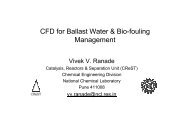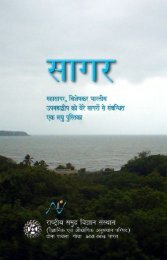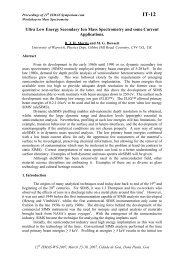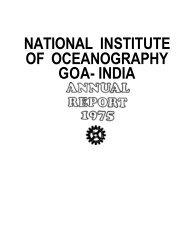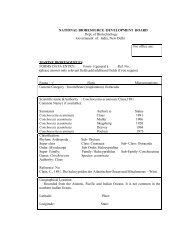1980 - National Institute of Oceanography
1980 - National Institute of Oceanography
1980 - National Institute of Oceanography
Create successful ePaper yourself
Turn your PDF publications into a flip-book with our unique Google optimized e-Paper software.
In the Ratnagiri, Mirya and Kalbadevi bays, the reserves <strong>of</strong> ilmenite upto<br />
a depth <strong>of</strong> 1 m were inferred to be 2 million tonnes. With the thickness <strong>of</strong> sand<br />
indicated by seismic records to be 21 m and with their probable extension upto the depths<br />
<strong>of</strong> 15 to 17 m, the total reserves in the other 13 bays may be many times greater. The<br />
extensive data collected during these surveys are being analysed and processed.<br />
The other organisations which collaborated in this project were the Oil &<br />
Natural Gas Commission, Geological Survey <strong>of</strong> India, <strong>National</strong> Geophysical Research<br />
<strong>Institute</strong>, Regional Research Laboratory (Bhubaneshwar), Physical Research Laboratory<br />
and the Birbal Sahni <strong>Institute</strong> <strong>of</strong> Paleobotany.<br />
3.3.2 Regional geology and manganese nodule deposits in the Arabian Sea and Central<br />
Basin <strong>of</strong> the Indian Ocean<br />
Necessary equipment such as Free Fall Grab, Boomerang grab, Radio marker,<br />
Underwater camera and Direction finder etc. for sampling and photographing the<br />
manganese nodules have been procured. The deep sea grabs and dredges have been<br />
designed and fabricated. A double beam atomic absorption spectrophotometer is<br />
being installed for the analyses <strong>of</strong> the samples. Based on the analyses <strong>of</strong> the data<br />
collected earlier, a cruise plan has been finalised.<br />
3 33 Geochemistry <strong>of</strong> the sediments <strong>of</strong> the continental margins <strong>of</strong> India<br />
Geochemical studies were continued on the sediment samples collected from<br />
the western continental margin between Ratnagiri and Mangalore, Mangalore and<br />
Cochin and from the eastern shelf between Ganges and Calimere Point. The findings<br />
<strong>of</strong> these studies are briefly given below.<br />
1. Western continental margin<br />
(a) Ratnagiri-Mangalore: In the bulk samples Si, Al, K, Na. Mg, Fe, Mn,<br />
Li, Cu, Co, Ni and Zn decrease while Ca and Sr increase as we move away<br />
from the coast but phosphorus does not show any distinct trend. The distribution<br />
<strong>of</strong> the elements in the HCl soluble leaches clearly indicates that the major portion<br />
<strong>of</strong> these elements is held in the clays. This is also confirmed by the strong correlation<br />
between Al and Fe, K, Na, and Mg. Negligible amounts <strong>of</strong> elements in the<br />
acetic acid leaches indicate that the adsorption by clay minerals and the Carbonate<br />
phase are not the significant factors for the fixation <strong>of</strong> the elements in these sediments.<br />
SiO2 content in these sediments is significantly less than the other nearshore<br />
sediments. This is mainly contributed by detrital quartz as indicated by the lack <strong>of</strong><br />
correlation between Al and Si.<br />
The outer shelf sediments are carbonate rich (75%) and biogenous while in<br />
contrast to the outer shelf, carbonate sediments in the northern part <strong>of</strong> the study<br />
area is oolitic in nature. Similarly, phosphorus in this area is associated with<br />
organic matter as indicated by the strong correlation between P2O5 and organic<br />
matter while in the northwestern region it is associated with carbonates.<br />
(b) Mangalore-Cochin: The concentration <strong>of</strong> Al, Mn, Cu and Zn in the bulk.<br />
41



